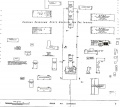Norman State Hospital
| Norman State Hospital | |
|---|---|
 | |
| Opened | 1895 (as a mental health facility) |
| Current Status | Active |
| Building Style | Cottage Plan |
| Location | Norman, OK |
| Alternate Names |
|
History[edit]
The first structure on the hospital site actually was a school for women opened in the late 1800s. High Gate Academy couldn't compete with the nearby University of Oklahoma, and in 1895 it was sold to the Oklahoma Sanitarium Co. Mental patients who until that time had been sent by train to a facility in Illinois could now be treated at the Norman institution “for violent insane,” as a description on the facility's front gate stated.
In 1899, sanitarium officials hired David W. Griffin, a psychiatrist from North Carolina.
Griffin would become superintendent in 1902, a position he would hold until 1950. The sanitarium was sold to the fledgling state of Oklahoma, and in 1915, the legislative “Lunacy Bill” created several state asylums, including facilities at Fort Supply, Vinita and Norman. The Norman site became known as Central State Hospital.
Patient populations at the Norman hospital grew, reaching 3,000 in the 1950s. At times, conditions reported there, as at many similar institutions of the era, were grim, with overcrowding, inadequate heating and cooling and use of electric and insulin shock therapy, sterilizations, lobotomies and other approaches now considered inhumane. Patients might remain there for months or years.
Beginning in the 1960s, medical approaches to treating the mentally ill evolved, and laws and standards of care with them. “Deinstitutionalization” began to wind down the era of huge residential mental facilities, taking much of the expansive Central State Griffin Memorial Hospital, as it was renamed in 1953, with it.
By 1990, only 245 patients remained at Griffin Memorial, which no longer needed the comprehensive and self-sustaining infrastructure it once had. Today, Griffin's patient capacity is only 120, and stays are measured in weeks or days.
Fire[edit]
The worst fire in Norman history, measured by the lives lost, killed 38 men and boys in the Oklahoma State Hospital for mental patients on April 13, 1918. That may have been the largest fire death toll in Oklahoma history. The State Hospital on East Main Street was a forerunner of l the Griffin Memorial Hospital. The fire broke out at 4 a.m. on a Saturday, destroying two large buildings, described by The Norman Transcript as "old frame" structures, and a new building used as the dining hall. All 38 victims were in a first-floor ward housing 48 boys 10 to 15 years old, the newspaper reported. Apparently some victims were attendants. All 36 patients in a second-floor ward were rescued, led down an outside stairway "by most strenuous efforts."
Eighty patients in the other destroyed ward building were evacuated safely. Firefighters were able to put out the flames in a third ward building, and patients who had been moved out were able to return. Others were covered with blankets on the grounds until they could be placed in other buildings. The Transcript reporter had high praise for both members of the Norman Fire Department and the hospital's fire department. “There were numerous instances of bravery in going into burning buildings," the story said, "but none of them take any special credit to themselves". There was speculation that either an electrical defect or spontaneous combustion started the fire. A coroner's jury said the cause was unknown. Property damage was estimated at $25,000).
All but one of the bodies were burned beyond recognition and were buried Monday in one big grave in the northeastern part of the IOOF Cemetery. "Everybody was laid in a neat coffin and given every kindly consideration possible," The Transcript said. Although the story: put the deaths at 37, The World Almanac calls it 38. Probably an injured patient died later.
Account of the fire[edit]
The night watchman smelled smoke in the linen room of Oklahoma State Hospital Ward 14 at 3:45 a.m. , on a spring Saturday morning in 1918. He quickly sounded the steam whistle at the hospital's power plant to wake the sleeping patients. Nurses, ward watchmen, and other employees fought the fire with hand-held extinguishers and a one-hose stream.
Night-shift attendants bravely began trying to evacuate the men and boys from the ward and the sleeping room above them. Dr. D.W. Griffin was on the scene within minutes, organizing rescuers.
The south wind was blowing fire debris and quickly caught the dining room on fire. Flames caught Ward 13 and 16 on fire but all 88 patients were safely evacuated and the flames beaten back. In all, about 1,000 patients were housed in the sanitarium that spring.
Some of the patients were violent and the fire excited them even more, making the rescue more difficult. A few were confused and ran back into the buildings. Sitting on the grounds, the attendants wrapped the patients with blankets and took a head count: Thirty eight men and boys out of 48 patients in Ward 14 were dead, mostly smothered in their beds. It is believed to be the highest number of deaths in a single Oklahoma fire, just outdistancing the 36 killed in the Babbs Switch school fire on Christmas Eve in 1924. [1]
Cemetery[edit]
At the northeast corner of the property of Central State Hospital is Rock Creek Road Cemetery, with rows of small concrete pads marking graves of many patients. In another nearby cemetery is a communal grave containing remains of 38 of the 39 people who died in a fire at the hospital in 1918.
The Norman IOOF Cemetery now houses the remains of the Fire Victims of 1918. The Victims were given a granite memorial with all 38 names listed see Findagrave.com for photos of memorial with full name list
Video[edit]
- This film documents the case of a mental patient in the 1950's and was filmed at this hospital.







